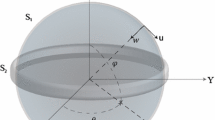Abstract
A mathematical model has been constructed for determining automatically the localisation of a class of detached retinal breaks. It includes a complete schematic eye in terms of the radius of curvature, centre of curvature and index of refraction. Computer control provides the surgeon with corrections from the apparent site for placement of an implant in a scleral buckling procedure. The arc length of settling back onto the choroid, measured on the posterior surface of the sclera and starting from the extension of the line of sight to the retinal tear, is the sum of two displacements, one solely due to geometry, the other to retinal relaxation. The geometric contribution is paramount because the maximum distance of detachment is taken to be small compared with the radial distance from the centre of the globe. Vitreous traction affecting retinal relaxation is replaced by an estimated overall stretch, satisfying an observed chordal distance between extremal points and distance of the detachment. The retina is assumed elastically homogeneous and isotropic and subject to a uniform normal surface traction directed inward. Displacements are predicted by means of a nonlinear theory for large displacements of membranes. Representative computer results are given for the vertical meridian.
Sommaire
Un modèle mathématique a été réalisé pour déterminer automatiquement l'emplacement d'un type de ruptures rétiniennes détachées. Il s'agit d'un oeil schématique complet tenant compte du rayon et du centre de courbure ainsi que de l'indice de réfraction. Le contrôle par ordinateur permet au chirurgien de corriger le site apparent lors du placement d'un implant dans une opération d' agrafage sur la schlérotique. La longueur de l'acc de retombée sur la chroïde, mesurée sur la surface postérieure de la schlérotique en commençant à partir du prolongement de l'axe de vision jusqu'à la rupture rétinienne, et la somme de deux déplacements: un uniquement dû à la géométrie, l'autre à la relaxation de la rétine. Le déplacement géométrique est l'élément essentiel, car la distance maximale de la partie détachée est considérée comme faible comparée à la distance radiale depuis le centre du globe oculaire. La traction de l'humeur vitrée affectant la relaxation rétinienne est remplacée par une traction globale correspondant à une distance chordale observée entre des points extrêmes et la distance du détachement. La rétine est supposée élastiquement homogène et isotrope et est soumise à une traction normale uniforme de sa surface vers l'intérieur. Les déplacements sont prédits à l'aide d'une théorie non linéaire pout les forts déplacements de membrane. Les résultats d'ordinateur représentatif sont donnés pour le méridien vertical.
Zusammenfassung
Es wurde ein mathematisches Modell zur automatischen Lokalisierung einer Klasse abgelöster Netzhautrisse konstruiert. Es schließt ein komplettes schematisches Auge mit Krümmungshalbmesser, Krümmungsmittelpunkt und Brechungsindex ein. Die Computer-Steuerung liefert dem Chirurgen Korrekturen von dem augenscheinlichen Sitz für die Anbringung eines Transplantats in einem skleralen Knickverfahren. Die Bogenlänge der Wiederabsetzung auf die Gefäßhaut, gemessen auf der hinteren Fläche der Sklera und beginning von der Verlängerung der Sichtlinie zum Netzhautriß, ist die Summe von zwei Verlagerungen: eine ausschließlich infolge der Geometrie, die andere infolge der Netzhauterholung. Der geometrische Beitrag ist am wichtigsten, weil der Maximalabstant der Ablösung in Vergleich mit dem Radialabstand von der Mitte des Augapfels als gering angenommen wird. Ein hyalines Ziehen, das die Netzhauterholung beeinträchtigt, wird durch eine geschätzte Gesamtstreckung ersetzt, wodurch ein beobachteter chordaler Abstant zwischen Extremalpunkten und Abstand der Ablösung befriedigt wird. Die Netzhaut wird als elastisch homogen und isotrop und einer gleichförmigen, normalen Oberflächenziehung nach innen ausgesetzt angenommen. Verlagerungen werden mittels einer nichtlinearen Theorie für große Verlagerungen von Membranen vorhergesagt. Für den vertikalen Meridian werden repräsentative Computer-Ergebnisse vermittelt.
Similar content being viewed by others
References
Boniuk, M. andButler, F. C. (1968) An autopsy study of lattice degeneration, retinal breaks, and retinal pitsin McPherson, A. (Ed.):New and controversial aspects of retinal detachment. Harper & Row, 59–75.
Cowan, A. (1928)Ophthalmic optics. Davies.
Drasdo, N. andFowler, C. W. (1974) Nonlinear projection of the retinal image in a wide-angle schematic eye.Brit. J. Ophthal. 58, 709.
Green, A. E. andAdkins, J. E. (1970) Theory of elastic membranesin Large elastic deformations. Clarendon Press, 161–169.
Pomerantzeff, O., Govignon, J. andSchepens, C. L. (1971) Wide angle optical model of the human eye.Am. J. Ophthal. 3, 815.
Schepens, C. L., Okamura, I. D. andBrockhurst, R. J. (1957) The scleral buckling procedures. Pt. 1—Surgical techniques and management.Arch. Ophthal. 58, 797–811.
Schepens, C. L., Okamura, I. D. andBrockhurst, R. J. (1958) The scleral buckling procedures. Pt. 2—Technical difficulties of primary operations.Arch. Ophthal. 60, 84–92.
Schepens, C. L., Okamura, I. D. andBrockhurst R. J. (1958) The scleral buckling procedures. Pt. 3—Technical difficulties of reoperations.Arch. Ophthal. 60, 1003–1012.
Schepens, C. L. (1968) Indications for photocoagulation, laser, and cryoapplications: a summaryin McPherson, A.:New and controversial aspects of retinal detachment. Harper & Row, 275–279.
Stine, G. H. (1934) Tables for accurate retinal localization.Am. J. Ophthal. 17, 314.
Author information
Authors and Affiliations
Rights and permissions
About this article
Cite this article
Engleman, M.S., Moskowitz, S.E. & Zauberman, H.L. Computer localisation of detatched retinal tears for a scleral buckling procedure. Med. Biol. Eng. Comput. 15, 564–572 (1977). https://doi.org/10.1007/BF02442286
Received:
Accepted:
Issue Date:
DOI: https://doi.org/10.1007/BF02442286




